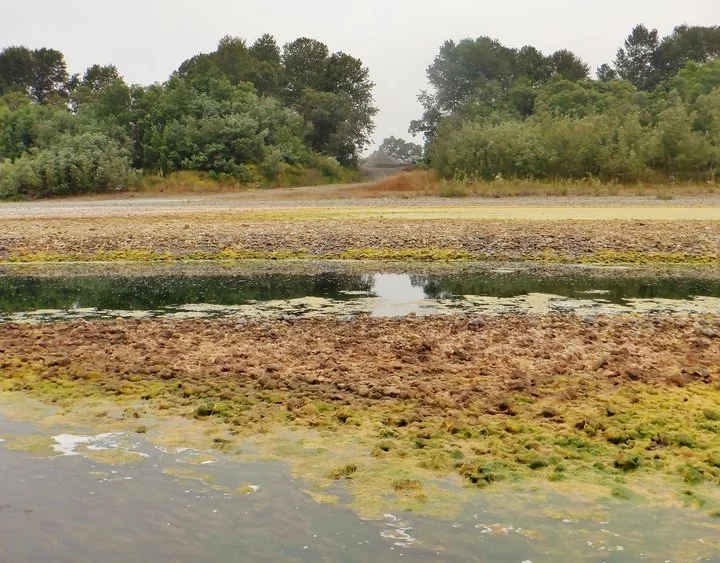Algal blooms on the lower Eel in years past. | Photo: Eric Stockwell.
###
Press release from the Humboldt County Department of Health and Human Services:
As we move into the fall and winter months, the Humboldt County Department of Health & Human Services, Division of Environmental Health (DEH) is providing an end of season recap of harmful algal bloom (HAB) activity locally noting that the instance of additional blooms for the year is low.
According to data provided largely from the North Coast Regional Water Quality Control Board (RWQCB), recreation waters in Humboldt County were impacted by eight individual reported HAB incidents between late July and mid-September.
HABs were identified through a combination of routine sampling of Big Lagoon by the Big Lagoon Rancheria, local agency response to reports from the community and sampling conducted by the RWQCB. Harmful algal species were identified in Big Lagoon, the South Fork of the Eel River and the Mad River. Active blooms that trigger posting of signage and public advisories are identified through a combination of visual indicators and direct testing for the presence of algal toxins.
Harmful algal blooms can occur in any freshwater body. Caused by multiple species of what are called cyanobacteria, they can look like dark green, bluegreen, black, orange or brown scum, foam or mats on the riverbed or floating on the water. Warm water and abundant nutrients can cause cyanobacteria to grow more rapidly than usual causing “blooms.” Most cyanobacteria do not affect animals or people, however, a small number of cyanobacteria species are capable of producing toxins that can be harmful to animals and humans. Dogs and children are most likely to be affected because of their smaller body size and tendency to stay in the water for longer periods of time.
This season the South Fork of the Eel River experienced blooms at six different locations—Richardson’s Grove, Redway Beach, Cooks Valley, Avenue of the Giants, Redwood Campground and one near Miranda. Of those, there was one confirmed report of a dog death likely attributed to exposure to algal toxins. One algal bloom was reported for Mad River, at a river access point in Blue Lake, with an unconfirmed report of human illness.
Sampling at Big Lagoon, the only recreational water body in the county that is afforded routine monitoring thanks to a federal grant awarded to the Big Lagoon Rancheria, detected concentrations of HAB toxins exceeding state safety standards. Harmful toxins were identified in samples collected on July 22 at three separate locations—exceeding the threshold for a public advisory warning against swimming and water contact by pets. The following sampling event on July 31 showed two locations having concentrations reduced from the “Warning” threshold to “Caution,” but one had elevated concentrations to nearly 10 times the “Danger” threshold—prompting a public advisory to avoid all water contact activities on the water body. Subsequent testing events showed toxin concentrations below actionable thresholds.
Moving into fall and winter, the likelihood of additional blooms this year is low—but never zero. Be observant when recreating and report areas experiencing large concentrations of algae to HAB experts at: CyanoHAB.Reports@waterboards.ca.gov or 844-729-6466 (toll free). Blooms can also be reported via the “bloomWatch” app available for free download on iTunes or Google play.
To learn more about cyanobacteria and harmful algal blooms, visit the state of California’s website at mywaterquality.ca.gov/habs/index.html.
To learn more about cyanobacteria and algae on the South Fork Eel River, visit eelriverrecovery.org/algae.
For information on conditions occurring within Humboldt County, contact DEH at 707-445-6215 or 800-963-9241. Photos of suspected blooms can also be emailed to envhealth@co.humboldt.ca.us.

CLICK TO MANAGE